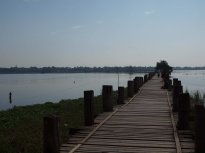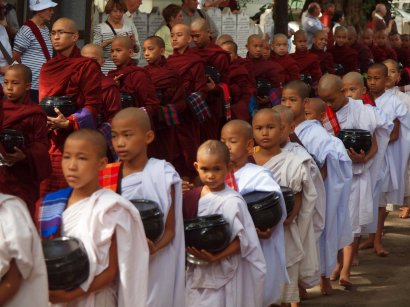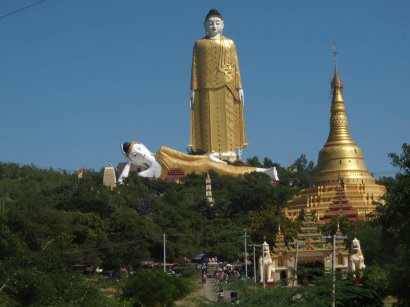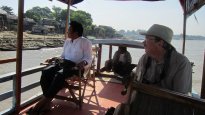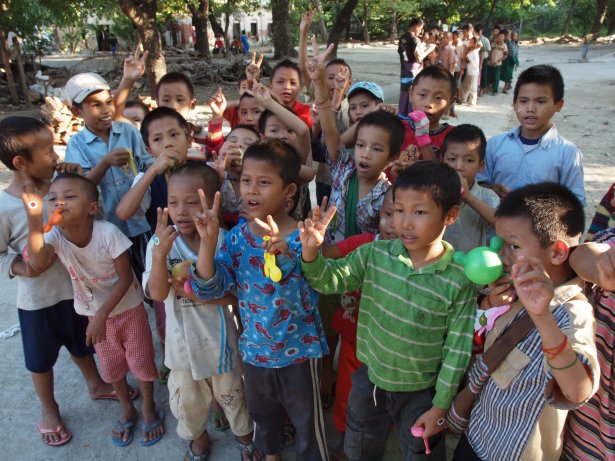The Road to Mandalay
We were on the “Road to Mandalay”, driving from the airport along a tree-lined street that was also lined with makeshift wooden huts with people bustling about. These were people who had their homes and fields destroyed by extensive annual flooding only a few months earlier and who were waiting for conditions to improve. We stopped at the “famous” U Bein bridge --- the one that you see in all the brochures or magazine articles about Myanmar.
U Bein bridge is apparently the longest wooden (teak) bridge in the world (1.5 km). The local people use it to cross the lake and it is the silhouette of monks and others against the setting sun, as they make their way across the lake, that has become a definitive image of the country . Of course the sun wasn’t setting so the mystique of the bridge was lacking but we got to walk halfway across, passing tourists and locals going about their daily business.
Our next stop was one of the largest monasteries in the country. Unfortunately it is a major stop on the tourist trail and most of the tour buses stop there . We were briefly shown around the monastery grounds , then jockeyed for a spot to watch the procession of the monks for their mid-day meal. Monks eat twice daily, early morning then just before noon. This meal would be their last until the next morning. The monks silently walk down the path in two long lines holding a large metal bowl to receive their portion of rice with meat or vegetables. No talking or smiles allowed! We learned from our guide that every Myanmar male at some time in his life becomes a monk, sometimes for only a week. We saw young “novice” monks as young as 6 and a lot of young men, all with shaved heads and dark red robes.
We then headed to the river to explore another monastery and old palace. We took a small wooden boat in dubious condition and transferred to a horse and cart. This is what I would definitely call “slow travel” as we toured the countryside for over 2 hours on very rough farm tracks. The horse was a wee bit reluctant to do his job and needed a lot of prodding. With the heat and rough surface I totally emphasize. The monastery and palace were interesting but it was the journey not the destination, that we will remember! Afterward we drove a few hours to our hotel. It had been a hot and very busy day and much to our delight, our hotel had a nice swimming pool.
Our destination the next day was some caves filled with Buddhas and the largest standing Buddha in the country. Again we had to cross the river in a sketchy looking boat. We drove for quite a way to see the caves, which were interesting enough.
But more interesting was the fact that Myanmar people were celebrating the “Light Festival” that happens around the full moon in October. The festival involves a visit to an important pagoda or temple, so the places we visited were more crowded than normal. At the largest standing Buddha in the country, the long walkway to its base was crammed with people going up or down. Clutching Len’s shirt in front of me, we made our way past vendors on both sides to the top plaza. The towering Buddha had stairs inside for a climb to the top for views but the heat was extreme and the crowds huge—we settled for a view from Buddha’s feet looking up!
Afterwards as we made our way to Mandalay to check out the pagoda and sunset views from Sagaing Hill. When we got caught up in a traffic jam, we realized that it was being caused by a parade to celebrate the light festival. Long processions of locals dressed in traditional costumes and dancing to loudly-amplifed music , filed pass our car. So colourful and exciting! Who cares that we almost missed the sunset views and had to rush at our last pagoda stop, Would all traffic jams be that exciting!
Mandalay, a relatively new city (1857),was a former capital of Myanmar. It was built around a palace and was a city of splendour for many years until fires destroyed much of the wooden structures and extensive bombing in WW2 destroyed the rest. As we entered town, we noticed how grimy and unattractive the streets of the city were. Our hotel was situated right downtown Mandalay on a dusty and chaotic road, and, as we had had enough of crowds and noise, we ate our dinner at the hotel and called it a night.
Our final day in the area was particularly unique. We were driven to the main jetty, where a private boat awaited. There are no docks or wharves for boats to tie up to, so boats pull up beside each other to load passengers. There can be up to 5 boats attached together. To get to the boat that is the furthest from the shore, you need to cross the decks of the other boats—literally “boat-hopping”. Our boat was a wooden structure that had an upper and lower deck. We sat on the upper deck barely big enough for 3 lawn chairs and thankfully covered by a tarp.
We were headed to Mingun, a village about one hour up river. It was wonderfully cool on the river, and we caught many glimpses of river life. After an hour we landed at a small village that has a number of pagodas and temples and the so-called largest bell in the world. It was stinking hot and we were glad to get back on the river for the return trip. Back in Mandalay , we visited a gold-leaf making workshop. Gold leaf is used by the local people to affix to a Buddha statue to gain personal merit. At the workshop 2 very buff young men took turns pounding a small package that contained leaves of gold leaf until each leaf was “tissue thin”. And they do this all day!
We saw another pagoda and teak monastery, but the highlight of the day was visiting a monastery where over 100 orphan boys lived. We met the abbot and presented him with $100 donation, then talked to the teacher monk. Then I had the wonderful opportunity to meet the younger boys (age 5 -10) and present them with a balloon (with Mickey Mouse ears!) and a sticker. The boys LOVED the balloons and I saw huge smiles on faces of children who really have not a lot to be happy about. Priceless memory – these are the moments of the trip I will never forget.
Photos
- Famous U Bein Bridge - the longest teak bridge in the world?
- 2012-10-29 10-19-09_0026
- 2012-10-29 11-47-36_0038
- 2012-10-29 12-42-57_0046
- 2012-10-30 09-09-40_0001
- 2012-10-30 10-11-20_0013
- 2012-10-30 12-20-58_0026
- 2012-10-30 12-54-33_0034
- Caught in a \"Light Festival\" Parade
- Local taxi
- 2012-10-31 09-55-01_0047
- 2012-10-31 11-42-28_0054
- How to get buff -- pounding gold leaf -- all day!
- Happy boys (now) at the Monastery orphanage
- Orphanage boys lining up for a balloon
